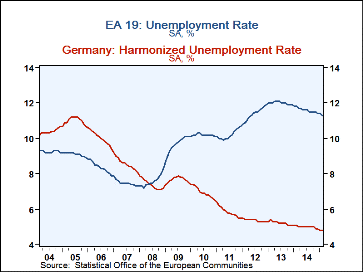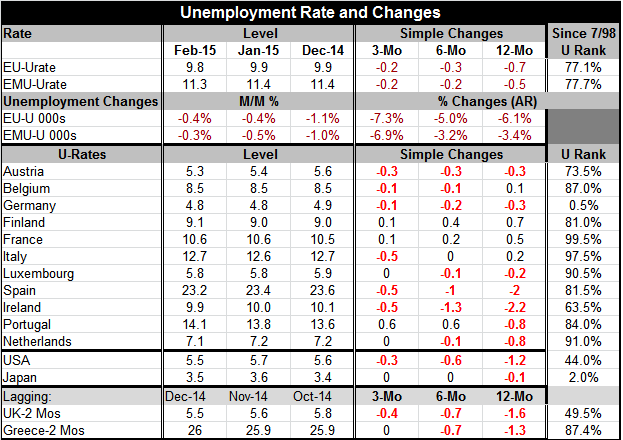 Global| Mar 31 2015
Global| Mar 31 2015Unemployment Rates Still Drop in Euro Area
Summary
Germany remains a world apart from the rest of the European Monetary Union members as its unemployment rate is less than half the average for the community. Germany's rate was steady in February as the rate fell in the EMU. In the [...]
 Germany remains a world apart from the rest of the European Monetary Union members as its unemployment rate is less than half the average for the community. Germany's rate was steady in February as the rate fell in the EMU.
Germany remains a world apart from the rest of the European Monetary Union members as its unemployment rate is less than half the average for the community. Germany's rate was steady in February as the rate fell in the EMU.
In the EMU, only Germany, Austria, Spain and Ireland have their respective rates of unemployment falling all horizons: three-months, six-months and 12-months. Only Finland and France have their respective rates of unemployment higher on all horizons. Still, for the 11 original members in the table, seven have lower unemployment over 12-months and six-months, while six have lower unemployment rates over three-months. Progress is still in train.
For all of the EMU, the unemployment rate is falling on all horizons and the overall rate is net lower over 12-months by 0.5 percentage points. This compares to the U.S. which also has an unemployment rate dropping on all horizons and has a net drop of 1.2 percentage points over 12-months. However, the U.S. unemployment rate is at 5.5% while the EMU rate is 11.3%. The U.S. unemployment rate stands in the 44th percentile of its queue of values since July 1998. On that same timeline, the EMU rate stands in its 77th percentile. The EMU rate has been higher only 23% of the time while the U.S. rate has been higher 56% of the time. On this timeline, the U.S. is performing much better. In the EMU, only Germany is performing better than the U.S. over this period as the German rate has been this low or lower only 0.5% of the time. German progress in reducing unemployment since German unification and since joining the EMU has been spectacular.
As shown in the chart, German unemployment has dropped by a great deal more than unemployment in the EMU in general. Until 2008, the German unemployment rate was higher than the EMU rate. Since then the German rate has dropped and the EMU rate has moved step-wise to higher levels. In the EMU, the unemployment rate has begun to come down but is moving slowly. The EMU rate was last this low in May 2012. Austerity has taken a toll on the unemployment rates in much of Europe and on their rates of growth.
The German economy has been able to thrive in this deprived global environment because it is an economy geared to succeed in a low inflation environment and because Germany is the most competitive among the highly industrialized economies. Germany has not had to undergo remedial economics as other countries have in the midst of a global slump.
In February, despite ongoing trend progress in unemployment, unemployment rates fell in four of the 11 EMU members in the table. In January unemployment rates had fallen in six of them.
While some measures are showing more progress occurring in Europe, such as in the recently released and comprehensive EU Commission indices, Europe still struggles. The bifurcated nature of the unemployment situation in the EMU is an issue (basically, Germany vs. everyone else). The ECB is attacking weak growth with its new QE program that seems to show some early signs of success. The pace of the decline in the EMU unemployment seems to be steady, but that pace is still slow for a region where unemployment rates are still so high historically. Can the ECB step up that pace? Apart from Germany and Ireland, all the EMU countries in the table show February unemployment rates that stand in the top 27% of their historic queue of data. Four countries stand in the top 20% of their respective queues, four more are in the top 10%- among those one that stands in the top one-half of 1%. There is still a lot of pain in the EMU. Unemployment rates in Europe are high and in great need of reduction. So far only Germany and Austria have found the key to low unemployment. But others are making various degrees of progress. It is that progress that we need to keep an eye on. It must continue. We will judge the EMU not by the performance of Germany but by the performance of its other more needy members.

Robert Brusca
AuthorMore in Author Profile »Robert A. Brusca is Chief Economist of Fact and Opinion Economics, a consulting firm he founded in Manhattan. He has been an economist on Wall Street for over 25 years. He has visited central banking and large institutional clients in over 30 countries in his career as an economist. Mr. Brusca was a Divisional Research Chief at the Federal Reserve Bank of NY (Chief of the International Financial markets Division), a Fed Watcher at Irving Trust and Chief Economist at Nikko Securities International. He is widely quoted and appears in various media. Mr. Brusca holds an MA and Ph.D. in economics from Michigan State University and a BA in Economics from the University of Michigan. His research pursues his strong interests in non aligned policy economics as well as international economics. FAO Economics’ research targets investors to assist them in making better investment decisions in stocks, bonds and in a variety of international assets. The company does not manage money and has no conflicts in giving economic advice.






